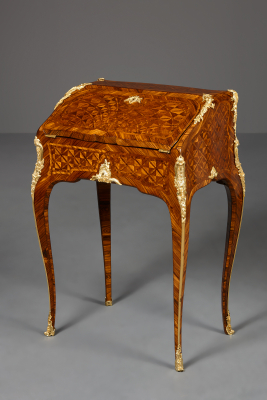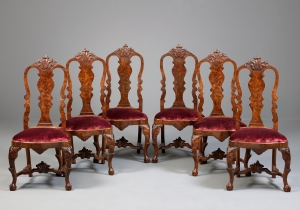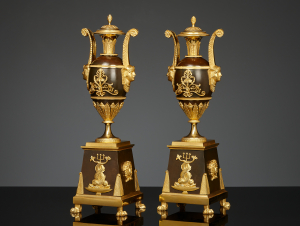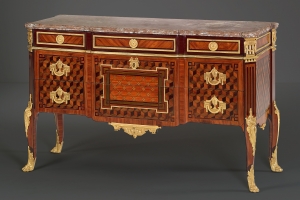French Louis XV Secrétaire en Pente, Pierre Garnier
French Louis XV Secrétaire en Pente, Pierre Garnier
An elegant lady’s writing desk with curved surfaces on all sides, resting on four slender, doubly arched legs. The secrétaire is veneered throughout with violet wood and adorned with parquetry of violet wood in large outlined cartouches. Its interior, behind a slanted flap, houses a compartment for documents and three drawers. The secretaire is richly decorated with gilt bronze with a high-quality embossment.
Writing furniture such as this one had a different function than the larger desks used in the study. The secrétaire en pente could be found in almost every room. It was equipped with the basic necessities for written correspondence, so that a letter could be drawn up immediately in the room in which one was present.
A Paris native, Pierre Garnier (circa 1726/27 - 1806) was trained in the workshop of his father, François Garnier (? -1774) on the Rue du Faubourg Saint Antoine. François was a committee member of the Parisian guild of carpenters and cabinetmakers (menuisiers-ébénistes) from 1742 until 1744 and was thus active in that position when his son was admitted to the guild as a maître-ébéniste on the last day of 1742. Pierre was no older than 15 or 16 at the time.
Pierre Garnier became an innovative and prominent Maître ébéniste during the second half of the 18th Century. However, despite the fact that he was one of the most renowned ébénistes of his time, he could not afford to devote all of his time to cabinetmaking and therefore specialized in the restoration and modification of older furniture as well. Pierre Garnier was also known for his work as Loueur de mobilier ordinaire, providing furniture for the interior of entire houses.
All bronzes are marked C Couronné. An edict dating 1745 required craftsmen to employ a mark on any alloy containing copper in the form of a distinctive lower case letter C surmounted by a crown. The “C Couronné” poinçon, also known as “C coronata” had to be applied to objects as well as furniture embellished or mounted with bronze elements.
The crowned C-mark, measuring just a few millimetres, had long been a much-debated issue for researchers- was it the signature of the bronzier Caffieri, that of the fondeur Colson, or the stamp of the furnituremaker Cressent?
It was not until 1924 that Henri Nocq, in his thesis Le Poinçon de Paris, identified it as a tax mark for bronze objects and fragments that was sanctioned between 1745 and 1749. As with any new tax, this one was very unpopular, triggering many artisans to formally contest the decision in lawsuits against the state. Nonetheless, the edict was formalised in February 1745 and became applicable to “all existent and new works of bronze, pure copper, cast iron, mixed copper, wrought-, ground-, hammered- planed-, engraved- gilded, silver or coloured- no exception.”
Every craftsman was required to report to the hall-mark office at the "cul-de-sac des Bourdonnais" in the Halles district, have his work stamped and pay the royalty fee. It was no coincidence that this all took place during the War of the Austrian Succession and that the military needs were urgent at the time. When the Treaty of Aix-la-Chapelle was signed in February 1749 and financing the king’s campaigns was no longer necessary, the "abolition of small new taxes" followed shortly.
Since the poinçon was obligatory for all metalwork containing copper, sold or exported, between March 1745 and February 1749, one can easily stumble upon the tax mark on pieces dating prior to 1745. For instance, if they received a new layer of gilding or if the objects were brought onto the market during these years. This is also the case with several pieces of furniture by André-Charles Boulle from the Louis XIV period.
A golden alliance coat of arms is stamped on the leather writing surface. It can be identified as the arms of alliance of the Neufville and d'Aumont families. This makes it very likely that this elegant piece of furniture belonged to the married couple Gabriel Louis François de Neufville de Villeroy and Jeanne-Louise-Constance d'Aumont, who married in 1747.
The French nobleman Gabriel Louis François de Neufville de Villeroy was the fifth and last duc de Villeroy, duc d'Alincourt, duc de Retz, marquis de Neufville, comte de Sault. Born on 8 October 1731, he was the son of François Camille de Neufville de Villeroy (1700-1732) and Marie-Josèphe (or Marie-Joséphine) de Boufflers (1704-1738), court lady of Queen Marie Leszczynska (wife of King Louis XV). On 13 January 1747, he married Jeanne-Louise-Constance d'Aumont (Paris 11 February 1731 - Versailles 1 October 1816), daughter of Lieutenant-General Louis Marie-Augustin d'Aumont de Rochebaron, duc d'Aumont, marquis de Villequier et de Nolay, baron de Chappes, d'Estrabonne et de Molinot, Pair de France,
premier gentilhomme de la Chambre du Roi. Her mother was Victoire-Félicité de Durfort de Duras. De Neufville became captain of the Garde du Corps du Roi in 1758. He succeeded his uncle Louis as duc de Villeroy in 1766 and also became governor of Lyon and the Lyonnais, Forez and Beaujolais. In that same year, he purchased the ‘hôtel de Beauharnais’ in Paris. De Neufville also owned the ‘hôtel de Villeroy’ in that city. In 1773, he was made a knight of the Ordre du Saint-Esprit and of the Ordre de Saint-Michel. In 1781 he was appointed lieutenant-general in the king's army.
On 28 April 1794, during Robespierre's reign of terror, ‘the bourgeois’ Gabriel de Neufville de Villeroy was guillotined in Paris. He was the last duc de Villeroy and the last descendant of his family, as the marriage to Jeanne d'Aumont was childless. However, the duke had fathered an illegitimate daughter, Anne-Camille, Comtesse de Vassan, in 1753 by his mistress Étiennette-Marie Périne Le Marquis (1737-1806), later the mistress of the Duc d'Orléans, known as 'Madame de Villemomble'.
Literature:
Christophe Huchet de Quénetain, Pierre Garnier, Paris 2003
- Provenance
- Very likely Gabriel Louis François de Neufville de Villeroy and Jeanne-Louise-Constance d’Aumont, 1747 Private collection, Germany
- Period
- ca. 1745
- Material
- oak frame veneered with kingwood, gilt bronze
- Signature
- Stamped: P. Garnier JME [bottom right]
- Dimensions
- 84 x 58 x 40 cm
Global shipping available











